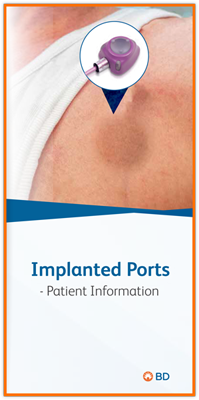

Select Language
What to expect after a port has been inserted?
There will be some tenderness and redness in the area where the port has been inserted. Usually, it goes away within 48 hours. In case the swelling does not go down or you notice unusual changes in the skin, consult your doctor.7
How will the doctor/nurse access the chemoport?
The ports can be used to provide medications/fluids or draw blood samples. The doctor/nurse will access the chemoport by placing a special needle (a non-coring needle) into the port septum. You may feel a mild pricking when they put the needle into the port.7
What does maintenance of the port entail?
After insertion, the port needs to be flushed when not in use. This procedure is done to ensure that the catheter does not become blocked. The port can be flushed before each treatment or infusion. Otherwise, ports generally have a monthly maintenance flushing cycle.7
Is a bandage required over the port?
You will need to wear a bandage on the area of incision until it heals. A bandage is not required when the port is not in use. However, during treatment, a bandage might be needed to apply to secure the needle.5,6
Are certain types of clothing recommended after port placement?
Consult with your nurse or doctor to know which types of clothes you can wear after port insertion. It differs based on where your port has been inserted.5,6
Can the port activate security alarms?
Most likely, security alarms will not detect the small amount of metal in the port. Even if it does, you can simply show your medical card or state that you have a port.5,6
Is it possible to get an MRI or CT procedure without removing the port?
Yes. You can get an MRI or CT with the port in place. Check with your doctor.7
Select Language

What to expect after a port has been inserted?
There will be some tenderness and redness in the area where the port has been inserted. Usually, it goes away within 48 hours. In case the swelling does not go down or you notice unusual changes in the skin, consult your doctor.7
How will the doctor/nurse access the chemoport?
The ports can be used to provide medications/fluids or draw blood samples. The doctor/nurse will access the chemoport by placing a special needle (a non-coring needle) into the port septum. You may feel a mild pricking when they put the needle into the port.7
What does maintenance of the port entail?
After insertion, the port needs to be flushed when not in use. This procedure is done to ensure that the catheter does not become blocked. The port can be flushed before each treatment or infusion. Otherwise, ports generally have a monthly maintenance flushing cycle.7
Is a bandage required over the port?
You will need to wear a bandage on the area of incision until it heals. A bandage is not required when the port is not in use. However, during treatment, a bandage might be needed to apply to secure the needle.5,6
Are certain types of clothing recommended after port placement?
Consult with your nurse or doctor to know which types of clothes you can wear after port insertion. It differs based on where your port has been inserted.5,6
Can the port activate security alarms?
Most likely, security alarms will not detect the small amount of metal in the port. Even if it does, you can simply show your medical card or state that you have a port.5,6
Is it possible to get an MRI or CT procedure without removing the port?
Yes. You can get an MRI or CT with the port in place. Check with your doctor.7
References:
- What Are My Options?: Infusion Therapy Vascular Access Device. Bard – Port Ready. https://portready.com/infusion-therapy/what-are-my-options/. Published 2022. Accessed August 17, 2022.
- Vascular Access Devices – Savannah Vascular Institute. Savannah Vascular Institute. https://www.savannahvascular.com/vascular-access-devices/. Published 2022. Accessed August 17, 2022.
- What Is A PowerPORT® Port?: Infusion Therapy Port Device Information. Bard – Port Ready. http://portready.com/infusion-therapy/what-is-a-port/. Published 2022. Accessed August 17, 2022.
- Maki DG, et al. (2006) The risk of bloodstream infection in adults with different intravascular devices: a systematic review of 200 published prospective studies. Mayo Clin Proc 81 (9): 1159-1171.
- BARD Implanted Ports Patient Information Guide. Adapted from https://www.bd.com/assets/documents/pdh/initial/Non-Power_Patient_Guide.pdf. Assessed on 03-06-21.
- Implanted Port Care. UPMC Hillman Cancer Center. Adapted from https://hillman.upmc.com/patients/community-support/education/miscellaneous/implanted-port-care. Assessed on 03-06-21.
- After Your Procedure: Infusion Therapy Patient Aftercare Information. Bard – Port Ready. https://portready.com/infusion-therapy/after-your-procedure/. Published 2022. Accessed August 18, 2022.
- BARD PowerPort Patient Guide web. Adapted from https://www.bd.com/assets/documents/guides/user-guides/PI_PV_PowerPort-Implantable-Port-Patient-Guide_UG_EN.pdf. Assessed on 03-06-21.